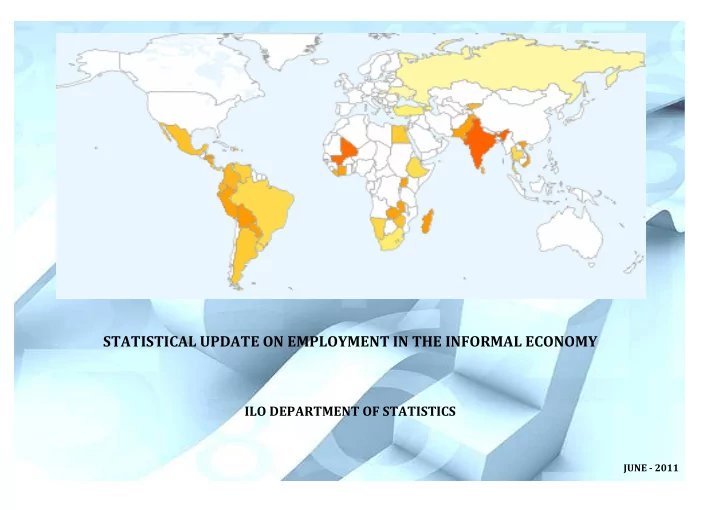

STATISTICAL UPDATE ON EMPLOYMENT IN THE INFORMAL ECONOMY ILO DEPARTMENT OF STATISTICS JUNE - 2011
Preface Informality in employment has always been a challenge for statistical The present statistical update presents information compiled for 46 countries measurement. In 2003, the International Conference of Labour Statisticians held from different regions. The data collection for the report represents a major in Geneva defined new concepts related to this topic. The main achievement was achievement and effort carried out jointly by STATISTICS and the global to develop guidelines for a new conceptual framework which distinguishes research-policy network known as Women in Informal Employment Globalizing between informality from the perspective of production units as observation and Organizing (WIEGO). The set of countries will be expanded in the future units on the one hand and that of jobs as observation units on the other. While and, from now on, the ILO will incorporate the data collected on this topic into the informal sector refers to informal enterprises, informal employment refers its main databases and conduct regular updates. to informal jobs. Employment in the informal economy can be defined as the sum of employment in the informal sector and informal employment found There are many offices and individuals whose efforts have made this report outside the informal sector. This new conceptual framework is seen as a key possible that I would like to acknowledge. First and foremost I would like to advancement to allow the analysis of informality which can serve as input to thank the National Statistical Offices which provided the information used in support policy making at the national level. this report, having been open to changing their data collection instruments and processing in order to introduce the new variables and follow the latest ICLS Since the adoption of the new guidelines, the ILO Department of Statistics recommendations. (STATISTICS) has been providing technical assistance to countries in order to support countries to introduce the new statistical measures in their national Secondly, I want to thank the Head of the Household Surveys Unit in our survey questionnaires. This has required a huge effort on the part of National Department, Ralf Hussmanns for having led this process and for having Statistical Offices worldwide and also from ILO technical staff. Following this provided extensive support to countries to make this possible. I would also like initial process, a project to compile and analyse the information was launched to thank Valentina Stoevska, Pablo Fleiss, Elisa Benes and Monica Castillo for by STATISTICS and the Employment Policy Department (EMP/POLICY) in order having contributed to this publication. I also would like to thank the colleagues to support the processing of statistical data on employment in the informal of ILO/SIALC who were responsible for collecting and processing the microdata economy and make it more widely available for data users and policy makers files of the countries in Latin America and especially Bolivar Pino who helped worldwide. provide technical support to these countries. I would also like to thank Azita Berar Awad who joined efforts and helped the process and encouraged joint collaboration with our Department. Rafael Diez de Medina, Director ILO, Department of Statistics 1
Main Findings In its most recent survey on employment in the informal economy conducted in Five countries (India, Brazil, Mexico, Vietnam and Pakistan) concentrate three- the first half of 2011, the ILO collected the most recent data available on key fourths of the total informal employment estimated for the group of countries. variables from 46 medium and low-income countries. In eleven countries, informal employment represents at least two-thirds of non- agricultural employment. The lowest percentages of informal employment are The two main variables for which data were collected include employment in observed in central and eastern European countries. the informal sector and informal employment, which refer to different aspects of the informalization of employment. Employment in the informal sector is an In all except two countries, the number of persons employed in the informal enterprise-based concept which is defined as jobs in unregistered and/or small sector exceeds those in informal employment outside the informal sector, unincorporated private enterprises; such enterprises are not constituted as suggesting that the bulk of informal employment is concentrated in employment separate legal entities (and are thus not officially registered) and do not in the informal sector among the countries. maintain a complete set of accounts. Informal employment is a job-based concept and encompasses those jobs that generally lack basic social or legal In over half of the 44 countries where we have data disaggregated by sex, protections or employment benefits and may be found in the formal sector, women outnumbered men in informal employment as a percent of non- informal sector or households. agricultural employment. However, the majority of the countries registered higher shares of men in informal sector employment as a share of non- agricultural employment as compared with women. Matrix: Employment in the Informal Economy Production Units Informal Jobs Formal Jobs Informal employment is negatively correlated with income per capita and Informal Sector Enterprises A B positively correlated with poverty across countries. This suggests that as GDP Other Units of Production C D increases and/or as poverty declines across countries, workers are more likely to be aware of their rights to certain legal and social protections and worker A+C = Persons in Informal Employment benefits and successfully achieve such protections and benefits. A+B = Persons Employed in the Informal Sector C = Informal Employment outside the Informal Sector B = Formal Employment in the Informal Sector A+B+C = Total Employment in the Informal Economy 2
Recommend
More recommend